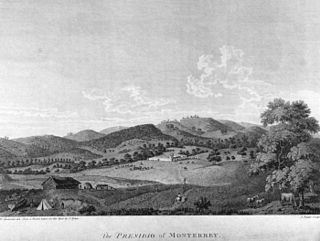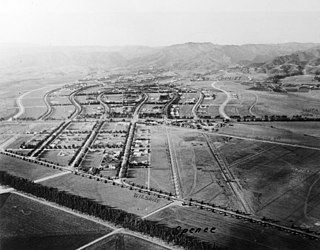
Captain Gaspar de Portolá y Rovira was a Spanish Army officer and colonial administrator who served as the first governor of the Californias from 1767 to 1770. Born in Catalonia into an aristocratic family, he is best known for leading the Portolá expedition into California, which laid the foundations of Spanish rule in the region Californian cities like San Diego and Monterey, and bestowed names to geographic features throughout California, many of which are still in use.

El Camino Real is a 600-mile (965-kilometer) commemorative route connecting the 21 Spanish missions in California, along with a number of sub-missions, four presidios, and three pueblos. Historically associated with a network of royal roads used by inhabitants of New Spain, the modern commemorative route in the U.S. state of California is named after these roads, with its southern terminus at Mission San Diego de Alcalá and its northern terminus at Mission San Francisco Solano in Sonoma, California.

The Presidio of Monterey (POM), located in Monterey, California, is an active US Army installation with historic ties to the Spanish colonial era. Currently, it is the home of the Defense Language Institute Foreign Language Center (DLI-FLC). It is the last and only presidio in California to have an active military installation.
Pedro Fages (1734–1794) was a Spanish soldier, explorer, and first lieutenant governor of the province of the Californias under Gaspar de Portolá. Fages claimed the governorship after Portolá's departure, acting as governor in opposition to the official governor Felipe de Barri, and later served officially as fifth (1782–91) governor of the Californias.

The Portolá expedition was a Spanish voyage of exploration in 1769–1770 that was the first recorded European exploration of the interior of the present-day California. It was led by Gaspar de Portolá, governor of Las Californias, the Spanish colonial province that included California, Baja California, and other parts of present-day Mexico and the United States. The expedition led to the founding of Alta California and contributed to the solidification of Spanish territorial claims in the disputed and unexplored regions along the Pacific coast of North America.

El Presidio Real de San Diego is a historic fort in San Diego, California. It was established on May 14, 1769, by Gaspar de Portolá, leader of the first European land exploration of Alta California—at that time an unexplored northwestern frontier area of New Spain.
Captain José Raimundo Carrillo (1749–1809) was Californio soldier and settler, known as an early settler of San Diego, California and as the founder of the Carrillo family of California.
José Francisco Ortega was a New Spanish soldier and early settler of Alta California. He joined the military at the age of twenty-one and rose to the rank of sergeant by the time he joined the Portola expedition in 1769. At the end of his military duty he would be granted land which he named Rancho Nuestra Senora del Refugio near Santa Barbara.

José de Gálvez y Gallardo, 1st Marquess of Sonora was a Spanish lawyer and Visitador general in New Spain (1764–1772); later appointed to the Council of the Indies (1775–1787). He was one of the prime figures behind the Bourbon Reforms. He belonged to an important political family that included his brother Matías de Gálvez and nephew Bernardo de Gálvez.

Old Town is a neighborhood in San Diego, California. It contains 230 acres (93 ha) and is bounded by Interstate 8 on the north, Interstate 5 on the west, Mission Hills on the east and south. It is the oldest settled area in San Diego and is the site of the first European settlement in present-day California. It contains Old Town San Diego State Historic Park and Presidio Park, both of which are listed on the National Register of Historic Places.

This timeline of the Portolá expedition tracks the progress during 1769 and 1770 of the first European exploration-by-land of north-western coastal areas in what became Las Californias, a province of Spanish colonial New Spain. Later, the region was administratively-split into Baja and Alta. The first section of the march was on the Baja California peninsula, and the northern section of the expedition's trail was in today's US state of California.
Miguel Costansó (1741–1814), original name Miquel Constançó, was a Catalan engineer, cartographer and cosmographer. He joined the Portolá expedition of Alta California led by Gaspar de Portolá and Junípero Serra, serving aboard ship as cartographer and on land as engineer.

The Portolá Trail Campsite or Portolá Trail Campsite No. 1 is the spot of the first Europeans to travel and camp overnight in what is now Central Los Angeles, California. The Portolá expedition camped at the site on August 2, 1769. The Portolá Trail Campsite No. 1 was designated a California Historic Landmark (No.655) on Sept. 26, 1958. The Portolá Trail Campsite is located in what is now the Elysian Park entrance, at the NW corner of North Broadway and Elysian Park Drive in the City of Los Angeles in Los Angeles County. The campsite is near the Los Angeles River, which they used as their water supply for the camp. Military officer Gaspar de Portolá was the commander of the expedition for the Spanish Empire with the goal of the Spanish colonization of the Americas. The expedition led to the founding of the first mission in the Los Angeles Basin, the Mission Vieja, on September 8, 1771, and of Alta California. The expedition arrived at Portolá Trail Campsite No. 1 from the San Gabriel Valley, were the Mission San Gabriel would be built later in 1776. As they depart Portolá Trail Campsite No. 1 they traveled west towards Santa Monica Bay, stopping at Portolá Trail Campsite 2, which is in present-day Beverly Hills. Portolá Trail Campsite 2 is also a California Historic Landmark (No.665). At San Monica Bay the expedition turned and traveled north to were the future Mission San Fernando would be built in 1797. Form San Fernando the expedition turned west to Ventura, the site of the future Mission San Buenaventura built in 1782.

The Portolá Trail Campsite 2 or Portolá Trail Campsite No. 2 is the spot of the first Europeans to travel and camp overnight in what is now Beverly Hills, California. The Portolá expedition camped at the site on August 3, 1769. The Portolá Trail Campsite No. 2 was designated a California Historic Landmark (No.665) on Nov. 5, 1958. The Portolá Trail Campsite is located in what is now 325 South La Cienega Boulevard between Olympic Boulevard and Gregory, in Beverly Hills. in Los Angeles County. Military officer Gaspar de Portolá was the commander of the expedition for the Spanish Empire with the goal of the Spanish colonization of the Americas. The expedition led to the founding of the first mission in the Los Angeles Basin, the Mission Vieja, on September 8, 1771, and of Alta California. The expedition arrived at Portolá Trail Campsite No. 2 from the Portolá Trail Campsite No. 1 in what is now Elysian Park. They came to camp site 1 from the San Gabriel Valley, were the Mission San Gabriel would be built later in 1776. As they depart Portolá Trail Campsite No. 2 they traveled west towards Santa Monica Bay. At San Monica Bay the expedition turned and traveled north to were the future Mission San Fernando would be built in 1797. Form San Fernando the expedition turned west to Ventura, the site of the future Mission San Buenaventura built in 1782.

The Carrillo family is a prominent Californio family of Southern California. Members of the family held extensive rancho grants and numerous important political positions, including Governor of Alta California, Mayor of Los Angeles, Mayor of Santa Barbara, Mayor of Santa Monica, and a signer of the Californian Constitution.

San Carlos was a Spanish packet boat built in 1767 at San Blas, Mexico. In 1775, under the command of Spanish naval officer and explorer Lieutenant Juan Manuel de Ayala, the San Carlos became the first ship to enter the San Francisco Bay.

Fort Stockton, later called Fort Dupont, was a historical fortress in San Diego, California, built in 1828. The Fort Stockton site is a California Historical Landmark No. 54, listed on December 6, 1932.

La Cristianita Canyon, or La Christianita Canyon, Los Cristianitos Valley, Canyon of the Little Christians, La Cañada de los Bautismos is a canyon now on the Marine Corps Base Camp Pendleton in San Clemente, San Diego County. La Cristianita Canyon is a California Historical Landmark No. 562 listed on December 31, 1956. The site was a campsite for the Spanish Commander Juan Bautista de Anza and Father Francisco Garcés expedition of 1775 and 1776. The expedition camped at the site in July 1769. At the campsite was a spring where the expedition rested and watered its stock of mules, cattle, and horses.

San Diego Viejo Plaza, also called Plaza de Las Armas, Old Town Plaza, and Washington Square, is a historical site in San Diego, California. The San Diego Viejo Plaza site is California Historical Landmark No. 63, listed on December 5, 1932. The plaza was the center of the Pueblo de San Diego, founded in 1835 in Alta California.

Spanish Landing is a historical site at Spanish Landing Park in San Diego, California, at San Diego Bay. The Spanish Landing site is a California Historical Landmark No. 891 listed on February 20, 1976. It is the site of landing by the Spanish Portolá expedition with leaders Gaspar de Portolá and Junípero Serra.


















